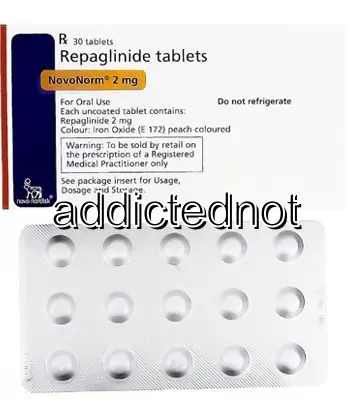| Package | Dosage | Price | Price per Dose | |
|---|---|---|---|---|
| Dosage: 0,5mg | ||||
| 360 pill | 0,5mg | €331.17 | €0.92 | |
| 180 pill | 0,5mg | €174.22 | €0.96 | |
| 120 pill | 0,5mg | €118.06 | €0.98 | |
| 90 pill | 0,5mg | €92.14 | €1.02 | |
| 60 pill | 0,5mg | €64.78 | €1.08 | |
| 30 pill | 0,5mg | €38.86 | €1.30 | |
| Dosage: 1mg | ||||
| 360 pill | 1mg | €528.45 | €1.47 | |
| 180 pill | 1mg | €275.02 | €1.53 | |
| 120 pill | 1mg | €192.94 | €1.61 | |
| 90 pill | 1mg | €159.82 | €1.77 | |
| 60 pill | 1mg | €109.42 | €1.81 | |
| 30 pill | 1mg | €64.78 | €2.15 | |
| Dosage: 2mg | ||||
| 360 pill | 2mg | €845.23 | €2.35 | |
| 180 pill | 2mg | €440.61 | €2.45 | |
| 120 pill | 2mg | €299.49 | €2.49 | |
| 90 pill | 2mg | €236.14 | €2.62 | |
| 60 pill | 2mg | €165.58 | €2.75 | |
| 30 pill | 2mg | €93.58 | €3.14 | |

Repaglinide Description
Overview of Repaglinide
Repaglinide is a medication commonly used to manage blood sugar levels in people with type 2 diabetes. It belongs to the class of drugs known as meglitinides, which work by stimulating the pancreas to release more insulin. This action helps lower blood glucose levels after meals, making it an effective option for controlling postprandial blood sugar spikes. Repaglinide is usually prescribed as part of a comprehensive diabetes management plan that includes diet, exercise, and other medications as necessary.
How Repaglinide Works
The primary mechanism of repaglinide involves closing potassium channels in the pancreatic beta cells. This leads to an influx of calcium ions, which triggers the release of insulin. Unlike some other diabetes medications, repaglinide acts quickly and has a short duration of action. This feature allows for flexible dosing, typically taken just before meals to match the body's natural insulin response. It effectively reduces blood sugar levels after eating, but it is important to use it consistently as instructed for optimal results.
Efficacy and Benefits
Many users report that repaglinide helps in achieving better blood glucose control, especially when used alongside lifestyle modifications. Its rapid onset means patients can see quick improvements in post-meal blood sugar readings. Additionally, because of its short action, there's a lower risk of prolonged hypoglycemia compared to some other insulin secretagogues. Some individuals find repaglinide convenient due to its flexible dosing schedule, especially if their eating habits vary. Overall, it can be a valuable option for those looking to manage their diabetes more effectively with a medication that acts quickly and is easy to incorporate into daily routines.
Possible Side Effects and Precautions
While repaglinide is generally well-tolerated, it can cause side effects in some users. The most common include hypoglycemia (low blood sugar), which may result in symptoms such as dizziness, sweating, or shakiness. Other possible side effects include headache, back pain, or gastrointestinal discomfort. Patients should be cautious and monitor their blood sugar levels regularly to prevent hypoglycemic episodes. It is essential to inform the healthcare provider of any other medications being taken, as repaglinide can interact with drugs like gemfibrozil, which increases the risk of hypoglycemia. People with liver or kidney issues should also discuss their condition with their doctor before starting this medication.
Usage and Dosage Recommendations
Repaglinide is usually prescribed to be taken before each meal, with the dose adjusted according to the individual's blood sugar response. Typically, the starting dose is low and titrated upward based on efficacy and tolerability. Patients are advised to follow their healthcare provider's instructions carefully and not to alter the dosage without consultation. Because of its short half-life, missing a dose or taking it at inconsistent times can affect blood sugar control. Proper timing around meals and adherence to the prescribed schedule are crucial for achieving the best results.
Conclusion
Repaglinide is a useful medication for managing post-meal blood glucose levels in type 2 diabetes. Its quick action and flexible dosing make it a convenient choice for many patients. However, it requires careful monitoring to prevent hypoglycemia and should be used as part of a comprehensive management plan. Patients should always consult their healthcare provider for personalized advice and guidance on using repaglinide safely and effectively. With proper use, it can significantly contribute to improved diabetes control and overall health outcomes.
